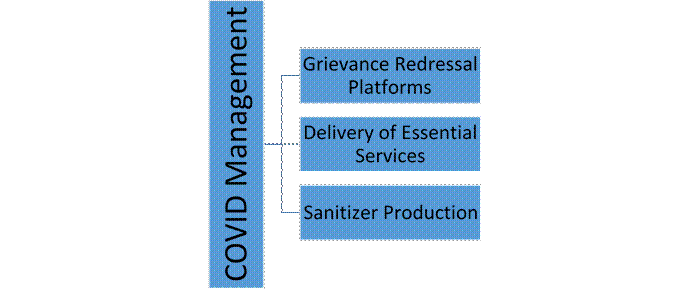Bokaro is a major city on the industrial map of Jharkhand, and in fact of India. Located in eastern Jharkhand bordering West Bengal, Bokaro is home to vast coal fields, along with a number of steel manufacturing plants, apart from a number of other industrial establishments. The population of about 21 lakhs is almost equally split between urban and rural areas. In 2018, Bokaro was chosen as one of the Aspirational Districts by the Government of India for the improvement of critical development indicators in health, education etc.
The purpose of this document is to inform the readers of the a few major activities that Bokaro Administration is involved in as a response to COVID-19, along with an inference on the lessons that this pandemic has taught vis-à-vis administration of the district.
A. Coordination plan
Given a more industrial and hence more connected character, Bokaro is at particular risk from the pandemic. Anticipating an escalated situation, a district level meeting — immediately post the announcement of the nationwide lockdown — was called under the chairmanship of Deputy Commissioner, Bokaro. To take into confidence all the important stakeholders and to bring everyone on the same page, a district level co-ordination plan was discussed. Tackling this unprecedented public health crisis prerequisites precise coordination of all important department.
B. Components of Core COVID Management in Bokaro
While the administration is taking a multi-pronged approach to address the pandemic, this report limits to explaining only three important initiatives

B 1. Grievance Redressal Platforms
In pursuance of the decision taken in the initial coordination meeting that technology must be leveraged in addressing the crisis, an Interactive Voice Response System (IVRS) was envisaged and implemented. The helpline number was widely publicized, both in print and social media for people to lodge various types of complaints, including black marketing, lacks of groceries etc. The complaint dashboard is handled by a dedicated call center made for this purpose, working round the clock. Grievance redressal is done in a decentralized fashion via field teams in all blocks and priority panchayats. At the time of this writing (14-Apr-2020), 1218 complaints have been registered on the IVRS, out of which 1205 are redressed. It is observed that the highest number of the complaints lodged are regarding delivery of essentials, including medicines and grocery to homes, followed complaints on black marketing. Given that the lockdown has been further extended till 3rd May, the IVRS system will be continued till the time the district administration sees fit.

B 2. Essential services
In Bokaro urban area, platforms such as Swiggy and Zomato are engaged to deliver groceries to households. A part of the delivery charge levied by them is deposited to the district disaster relief fund. Big Bazaar, Reliance Fresh and other small retailers are engaged in home delivery of essentials. Other than this, the administration has permitted about 57 grocery stores across all the blocks of Bokaro to home-deliver groceries.
Secondly, the District Administration, under the umbrella “Smiling Bokaro” is also delivering packed vegetables at a fixed price. Commodities and vegetables are sold at controlled rates, as decided by the district administration. Hence, a decentralized approach involving both the government and private players is employed here.

Lastly, to serve the under-privileged, about 95 free Dal Bhat Kendras (DBKs), along with 3 mobile food delivery vans have been established. As of this writing (14-04-2020), pinning of all DBKs on google maps, and establishing CCTV cameras in all DBKs are ongoing.

Mapping of Dal Bhat Kendras
B 3. Sanitizer Production
Using the Disaster Management Act, an alcohol bottling plant was seized, converting it into a hand sanitizer production unit. Given that the raw material used for making the sanitizer is the same as the one for manufacture of liquor, the plant was recalibrated for the production of sanitizer. The plant has produced around 10,000 liters of hand sanitizer, following the production protocol released by the World Health Organisation. Around 20 SHG women were employed in certain production processes, especially bottling, labeling and packing. At a time when sanitizer availability in bulk quantity was a problem, an in-house production unit came as a boon not just to Bokaro but beyond. The hand sanitizer has been supplied to:
- Districts in Jharkhand: Godda, Hazaribagh, Chaibasa, Deoghar, Ramgadh, Dhumka and Sahibganj
- Districts in Bihar: Jamui, Madehpura, Nawadah
- Institutions: KM Memorial Hospital, Electro Steel, BPSCL, EC Railways, CRPF, Home Guard, JAP 4, JSLPS, BSL, Banks (BoI, SBI, Canara, UCO, Union Bank).

Hand sanitizer production unit
C. How has Bokaro leveraged local-available resources/expertise in tacking the pandemic?
- Given that Bokaro is an industrial city, it has used a private alcohol bottling plant to manufacture the critical hand sanitizer.
- Given that many PSUs in Bokaro have their own guest houses, they are now converted to quarantine centress.
- Leveraging of platforms such swiggy/zomato which operate in the urban areas.
- Leveraging of civil society, especially Rotary club for home delivery of supplies, especially vegetables.
D. Disaster preparedness leading to institutional strengthening and vice versa
A striking and a very welcome outcome of disaster preparedness is that the existing machinery is being strengthened. Two examples to make it concrete:
- The Health Department is at the fore-front in this fight. Along with the administration, it is working in numerous aspects such as setting quarantine and isolation centres according to protocol, involved in ground level surveillance, testing of suspect cases, contact tracking and meticulous data management on all these issues. Once this pandemic is over, and given that COVID has evoked so much preparedness, the practices can be extending to strengthen the fight against other diseases as well.
- Only in about a week, the number of dal bhat kendras across the district had gone from 19 to 95. Other than this, the food supply for the distribution of dry ration was expanded and strengthened. Welfare schemes pertaining to distribution of pension was accelerated on a war-footing.
The pandemic has shown how efficient administration can become, and hopefully the lesson are carried forward in the post-pandemic phase. Going forward, a district wise pandemic micro plan may be made for better dealing of such situations in the future.

